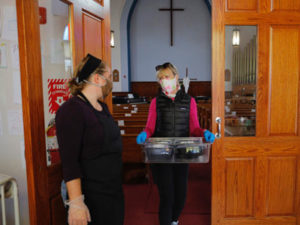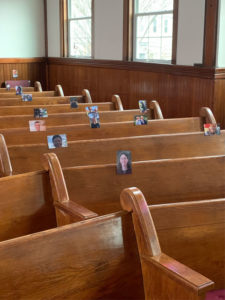“Death and Resurrection as Ecclesial Imagination”
Fourth Presbyterian Church
Boston, MA
By Kevin Vollrath
 I casually mentioned to Fourth Presbyterian’s senior pastor, Burns Stanfield, at the beginning of our interview that I was feeling refreshed after an afternoon run in the crisp fall air. I felt that offering more of myself would be helpful for building rapport. I had learned so much about Burns and his church, and he so little about me, and I simply wanted to tip the scales. Burns runs, too (which didn’t shock me since this is Boston, after all.) He runs marathons to raise money for the church. His first fundraising marathon was to purchase the building—known as 5 Vinton, immediately adjacent to the main church building—from which he was Zooming me. The fundraiser was for the main church building, but the estimated cost of the building improvement and expansion plan kept increasing as they raised funds for various reasons. As Burns put it:
I casually mentioned to Fourth Presbyterian’s senior pastor, Burns Stanfield, at the beginning of our interview that I was feeling refreshed after an afternoon run in the crisp fall air. I felt that offering more of myself would be helpful for building rapport. I had learned so much about Burns and his church, and he so little about me, and I simply wanted to tip the scales. Burns runs, too (which didn’t shock me since this is Boston, after all.) He runs marathons to raise money for the church. His first fundraising marathon was to purchase the building—known as 5 Vinton, immediately adjacent to the main church building—from which he was Zooming me. The fundraiser was for the main church building, but the estimated cost of the building improvement and expansion plan kept increasing as they raised funds for various reasons. As Burns put it:
But meanwhile we were building up some cash some savings. And when this building went for sale, we had enough that we could make a really good down payment and deal with some deferred maintenance on our building that we were deferring in part because we were planning to renovate, so it actually felt very godly. I mean it really felt like we had just let go; we had just said there’s no way we can do this, we’re going to just have to start fixing the roof and doing these other things. And this building went on the Paulet and it was 2006 and we said ‘Well okay, I guess this would help us address our space needs and also build in some flexibility because you can rent upstairs and if you were really in a pickle, you could rent downstairs and anyway, . . . it gave us our one and only parking lot into it in squeeze six cars if you park very carefully.’
“Fourth Pres,” as they refer to it, has faced a number of challenges. Instead of ending the story, though, challenges provide the fertile ground for discerning new possibilities for understanding God and their participation in God’s mission. Rising building costs were not simply an obstacle to following their understanding of God’s will, but a means of pivoting to another possibility. Burns thoughtfully agreed with my assessment that this seemed like a perfect purchase for the church, perhaps better than their original construction plan. Their ecclesial imagination consists of constantly imagining and negotiating what could be next for the church and best for their community, trusting that God is faithful in guiding them and the world they love.
That wasn’t always so clear to me, though. I initially thought the church’s imagination focused on feeding people. I saw “#fedatfourth” all over their social media and website, along with food in most pictures. When the pandemic hit and schools were no longer giving students free or reduced lunches, the state asked them to expand their summer meals program. They started in March and haven’t stopped, feeding 200 people lunch every day. After asking Burns about this, I was surprised and nervous to experience his very hesitant half-groan when I mentioned my observation. I was nervous that I was somehow missing something very key to the church; in fact, I had. Burns explained that “food is a great piece of community building,” but it’s really just a means for getting people together.
Food gets people together: to prepare, serve, and eat. Fourth is a place where people can be together, and just as importantly, where people want to be together. That’s a mission that’s never complete, which can’t be stopped by a pandemic, and which satiates deep hunger. It became clear later in the interview that Burns desperately wants to be together. His hope for the church post-COVID-19 is to be together again, to reconnect. Apparently nightly Zoom prayer with current and former church members isn’t enough!
“Being together” doesn’t completely capture the theological dimension of their ecclesial imagination. I started thinking about the church’s history and some of the events that have shaped it more profoundly than the few words I heard about them might suggest. History is the best way to describe the church’s ecclesial imagination, which I call “death and resurrection.” Despite lacking these words at the time, I started thinking of Fourth in these terms when I heard Burns’s description of the church’s high and low points. He identified three stories as high points, all of which initially sounded like low points to me, but somehow made their way to resurrection.
Fourth Presbyterian Church was founded in South Boston in 1870. It currently exists between two housing projects, fitting for the heart of its mission to serve the neighborhood, “touching the lives of well over 650 people every month.” When Burns started at Fourth 25 years ago, they were surviving on a redevelopment grant from the Presbyterian C(USA) which would expire two years into Burns’s tenure. This bothered Burns more than the congregants, but instead of leading to apathy or despair, it was the impetus for his creativity. He was constantly trying new things to find what worked, and some of those ideas ended up sticking for a long time! This may be the paradigmatic example of Fourth pivoting their ministry in light of apparent obstacles.
Strikingly, Burns also identified the church’s 2006 bomb threat as a high point. As Burns put it, “it was like a bad movie, where they had cut out letters from magazines and said, ‘We bomb you.’ It was stuck in our mailbox. And it used a bunch of racial epithets and gay epithets. And I thought, oh, like, what’s this about? Like, we are trying to be a welcoming place.” Burns was so hurt by this because he sincerely wants Fourth to be a place where all are welcome. I was initially confused by his interpretation that this threat was precisely antithetical to the church’s vision of welcome. Now I see that the bomb threat not only threatened the belonging of queer and people of color, it also implied that the writer of the threat—whoever they were—did not feel welcomed at the church, which was an additional threat to the church’s identity.
The church’s session (governing board) decided to have church anyway and it was one of their most attended services. Most members were there; only their seminary intern was afraid to attend. In subsequent weeks, friends from local synagogues and Black churches also attended in solidarity. Local politicians and others in the community also came to show their support, to say, “This is not who South Boston is.” For Burns, the whole event was a high point because he “felt like we weren’t alone.” The bomb threat was transformed from a threat to life and being together into a new way of being together with new people. The threat from the community became an opportunity for deeper union with that community. The threat to the church’s identity as welcoming became an opportunity to show just how welcoming they are.
In addition to the threat of death, Fourth Church has also faced actual death on multiple occasions. One member, Lee, sat in front of Paul at church for more than ten years. As a deacon, Paul was responsible for checking in on several church members, including Lee. Paul volunteered to visit Lee in the hospital when he was sick and offered any help he could provide. Paul described an intimate moment he had in the hospital while visiting Lee. Remembering many Sundays in church hearing Paul’s voice, Lee asked Paul to sing for him. Paul recalled, “The only song I know is ‘Jesus loves me,’ you know, and he asked me to sing, and I know I screwed up some of the words, but I sang, I sang to him.” Lee died within the hour, after Paul left to buy him lottery tickets.
While Lee died in a very real way, his memory clearly lives on at Fourth Church. The opportunity Paul had to minister to Lee in such a vulnerable time encourages the congregation in faithfulness to God and each other. His vivid paintings live on in the church office, reminding the associate pastor, Molly, of The Chronicles of Narnia and that “part of what makes Fourth Fourth is just like the anthology of characters that are in [that] place, held together through love and loose tension in varying forms at varying times.”
 Three years ago, Burns’s wife Irene, a doctor and active member of the church, passed away. I am not sure how Irene’s death impacted Fourth in the immediate sense but Burns and several in the focus group commented that her death prepared the church for dealing with COVID-19. Hosting the funeral at Fourth forced them to expand their Wi-Fi and other technological capabilities. Brianna, now an active member and vocal at every event I attended, joined the church after Irene’s death to help fill her spot in the choir and to be a friend to Burns. Irene’s cancer diagnosis was also the time Molly became associate pastor at the church. That is presumably coincidental, but because her position is grant-funded, it implies that the church was still growing amid Irene’s sickness. Many community members started asking congregants about how Burns was doing in the aftermath of Irene’s death. Burns stopped short of calling his wife’s death a high point in the history of the church, but Molly called it “the biggest low point . . . And that was also a period of like, having to reinvent everything.” Molly also acknowledged the creativity that resulted from this. I’m not sure who first noticed the ways Irene’s death prepared the church for this pandemic, but I imagine it would take courage to share that thought. That someone could name the good that came from an especially painful death further signifies that Fourth is a place where death is not the end.
Three years ago, Burns’s wife Irene, a doctor and active member of the church, passed away. I am not sure how Irene’s death impacted Fourth in the immediate sense but Burns and several in the focus group commented that her death prepared the church for dealing with COVID-19. Hosting the funeral at Fourth forced them to expand their Wi-Fi and other technological capabilities. Brianna, now an active member and vocal at every event I attended, joined the church after Irene’s death to help fill her spot in the choir and to be a friend to Burns. Irene’s cancer diagnosis was also the time Molly became associate pastor at the church. That is presumably coincidental, but because her position is grant-funded, it implies that the church was still growing amid Irene’s sickness. Many community members started asking congregants about how Burns was doing in the aftermath of Irene’s death. Burns stopped short of calling his wife’s death a high point in the history of the church, but Molly called it “the biggest low point . . . And that was also a period of like, having to reinvent everything.” Molly also acknowledged the creativity that resulted from this. I’m not sure who first noticed the ways Irene’s death prepared the church for this pandemic, but I imagine it would take courage to share that thought. That someone could name the good that came from an especially painful death further signifies that Fourth is a place where death is not the end.
The COVID-19 pandemic is another challenge the church must face, which the church has attended to and from which it has grown. Molly said it was the same kind of crisis as Irene’s death, but this time, the whole world was suffering through it with them: “I feel like I’m gonna be okay, because I’ve gone through this rodeo before, like, I know you can get to the other side. In ways that other people around us were not saying, especially in March.” Lindsey, Burns, and Christa were all clear that COVID-19 was a source of conflict and tension in the church. It seems like Lindsey suffered from it more than others; perhaps hers was the dissenting voice in some of the church’s decisions.
The COVID-19 pandemic was the impetus for their growing food ministry. It gave them the opportunity to expand their Summer Meals program, usually just eight weeks of lunches for grade school children. They had always wanted to do more but were limited by the state. Now, though, the state subsidized their extended meal program and food pantry. Other expressions of the church’s mission had to fade away because of the pandemic, so food ministry seemed to be their main ministry during the pandemic. Despite the challenges of COVID, and the very real death of many loved ones, Paul experienced the resurrection of COVID by suddenly being able to attend church seven days per week remotely. Becca hopes to not stop hearing from people as much once the pandemic is over. Lindsey looks forward to a big, overdue celebration on the other side of this.
I assume because this challenge is more recent, I heard more of the nuance of its negative impact on their church than I did about older events. I wonder, though, how the church will reflect on the season of COVID-19 five, ten, fifteen, or even twenty years from now. Will they remember the challenges as clearly as the opportunities?
Responding to the problem of separation and division in the world, Fourth Church is a place where people of all kinds gather and can expect to be welcomed and accepted. Though they don’t discuss their theology explicitly very often, I sense a conviction that this mission cannot be thwarted, that God’s mission in them cannot be stopped. In the focus group, no one expressed doubt that the church would continue thriving after COVID-19. The question is just how their expression of mission will continue to modify, which is based on which opportunities come their way. For example, feeding people seems like a central piece of the church’s mission in the pandemic, primarily because other aspects of their mission have had to stop for pandemic. It’s not obvious whether they’ll continue with their state-sponsored food pantry and free and reduced lunches after the pandemic or whether evening prayer will continue in the same form, but they’re committed to building on what they have.
This implicit belief that their mission cannot be thwarted enables them to sit with and learn from the challenges they face. They run with perseverance the race marked out for them, surrounded by their own cloud of witnesses, seeking the joy set before Jesus on the other side of the cross (Hebrews 12:1-3). Their desire to be together in various ways is an expression of the cloud of witnesses. As associate pastor Molly said, in her 10 years at the church they’ve only stopped doing one or two programs. They keep adding programs without subtracting! I think that’s a way of creating more ways to connect, taking into consideration the various barriers to being together (like hunger and police brutality.) This is important because people need a place to connect, a place they want to be and that wants them there. In further research, I would love to hear the origin stories of more ministries at Fourth. I wonder if many of them were born out of crisis or redirection of vision.
Molly’s comment that the number of programs the church hosts continue to grow, though, helped me realize that the fruit born by one crisis is long-lasting. The church’s shoe-string budget 25 years ago led to Burns’s risk-taking and creative impulses, which still echo today. The failed building campaign led to the purchase of another building which provides a parking lot, much-needed office space, housing for a congregant, and space for multiple socially-distanced programs. The bomb threat led to a deeper sense of identity and stronger relationships with local synagogues and Black churches. Irene’s death provided technological and emotional resilience to weather the COVID-19 storm. Because of COVID-19, Fourth is now providing 200 meals a day and daily prayer services that connect people around the world. At first, I thought this pattern was simply Burns’s optimism or making lemonade out of lemons. Now, I think it reflects something deeper about the church. Beginning new ways of being together during COVID-19 isn’t an effect of optimism alone. Fourth imagines life to be a gift from God, and God’s mission cannot be stopped even by lack of money, a global pandemic, or death. Fourth takes these challenges diligently, and God is faithful to Fourth in providing alternate ways to fulfill their mission of being a place where people connect. The challenges the church faced were brief, but they still bear fruit. Death is short, but resurrection is forever.
After some prodding, Burns did admit that the real low points in the church have been when people died. At first, I thought this was a low point because it prevents people from being together; but, now I think it is rather fitting that I attended the All-Saints Day service, which showed me just how much the church mourns death but won’t be stopped by it. Several members of the focus group told stories of deceased members. The memory of the deceased in the form of stories also bears long-lasting fruit.
Much more could be said about Fourth, even on the theme of “death and resurrection.” I only visited online one of their several healing and recovery groups, which feature much vulnerability and diversity in experience. Spending more time with Fourth, especially in person, would have helped me understand the depth and character of relationships that help them thrive through COVID-19.
Some congregants expressed moderate concern about the future of the church once Burns eventually leaves. He’s clearly had a positive impact in revitalizing the church. His voice figures prominently in this portrait, but I tried to make this portrait mirror his leadership: present everywhere at the beginning and gradually less as other leaders step forward. As I reflect on the church’s theological imagination, though, I suspect and hope that whenever Burns is ready to leave, Fourth will continue to navigate their death to resurrection DNA. His departure may be a kind of death, but I have faith and hope that it, too, will bear fruit as Fourth faces the opportunity to grow and adapt once more.


